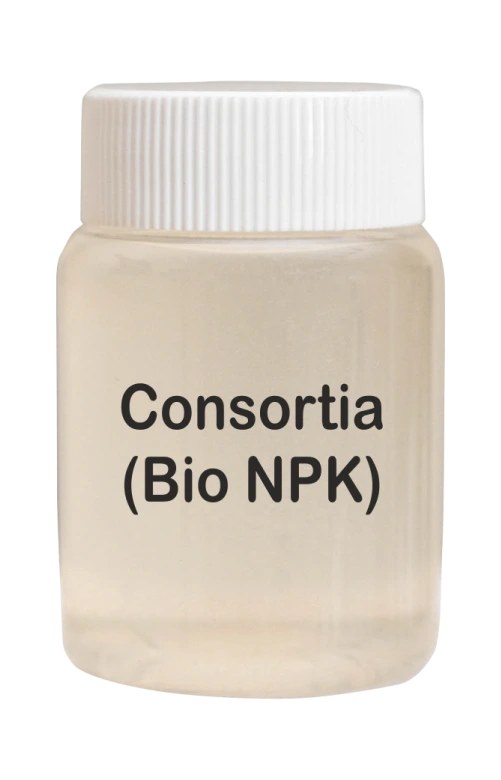


Bio Fertilizer Liquid
Consortia ( Bio NPK )
 Share On Whatsapp
Share On Whatsapp

A consortia is a mixture of multiple microorganisms that, residing in the rhizosphere, have a direct or indirect impact on the structure and yield of natural plant populations.
Bio NPK is a blend of Azotobacter, Phosphate Solubilizing Bacteria, and Potash Mobilizing Bacteria; when combined, they provide a comprehensive nutritional solution for the crop.
| Parameter | Details | |
|---|---|---|
| Base | Liquid | |
| Viable Cell Count | CFU minimum in a mixture of any 2 or maximum 3 of the following microorganisms:
Total Viable Count: CFU minimum 1.5 x 108 cells per ml | |
| Contamination Level | No contamination at any dilution | |
| pH | 5.0–7.0 | |
| Efficiency Character | The efficiency character of individual microorganisms to be determined as mentioned in the case of individual biofertilizer quantitative estimation method. | |
- Azotobacter: This microorganism has the ability to fix atmospheric nitrogen, reducing the dependency on synthetic fertilizers. It can fix nitrogen up to 20–40 kg per hectare, providing an important source of nitrogen for plant growth.
- PSB (Phosphorus Solubilizing Bacteria): PSB produces organic acids that assist in the uptake of phosphate, leading to increased maturity and enhanced yield. The production of organic acids such as malic, succinic, fumaric, citric, tartaric, and acetic acids accelerates phosphate availability and uptake by plants.
- KMB (Potassium Mobilizing Bacteria): KMB enhances crop resistance against diseases and stress conditions. It also secretes growth hormones, which can increase crop productivity. By mobilizing insoluble potassium, KMB reduces the need for potash fertilizers by 50–60%.
- Supply of Essential Nutrients: The Bio NPK consortia ensures the supply of essential nutrients in optimal quantities to the crops. This balanced nutrient availability promotes healthy plant growth and development.
- Prevention of Micronutrient Deficiency: The consortia helps prevent micronutrient deficiencies that may occur at different growth stages of crops. By supplying a complete range of nutrients, it ensures that the crops have access to the necessary elements throughout their growth cycle.
- Chelation with EDTA: The presence of EDTA (Ethylenediaminetetraacetic Acid) chelates in the consortia facilitates the fast absorption of all individual microelements by plants. This improves the efficiency of nutrient uptake, ensuring that plants receive the required microelements for optimal growth and development.
Recommended Crops
Grapes & Banana, Citrus, Mango, Tomato, Pomegranate, Groundnut, Cotton, Soyabean, Coconut, Potato, Brinjal, Onion, Garlic, Cumin, Chilies, Beans, Okra, Pea, Tomato, Cabbage, Cauliflower, Sugarcane, Paddy, Rice, Wheat, Sorghum, Bajra, Lawns, Gardens, Green House, Etc.
Application
- Seed treatment
- Seedling treatment
- Soil application
- Drip irrigation
Dosage:
1 Liter/Acre
Packaging:
200-Liter HDPE Barrel


